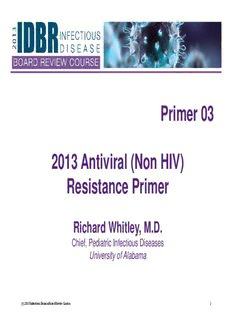
03 - Antiviral Resistance Primer - Whitley PDF
Preview 03 - Antiviral Resistance Primer - Whitley
Primer 03 2013 Antiviral (Non HIV) Resistance Primer Richard Whitley, M.D. Chief, Pediatric Infectious Diseases University of Alabama (c) 2013 Infectious Disease Board Review Course 1 DISCLOSURES Financial Relationships with Relevant Commercial Interests • None (c) 2013 Infectious Disease Board Review Course 2 Herpes Viruses (c) 2013 Infectious Disease Board Review Course 3 Herpes Viruses • Selective pressure contributes to the development of resistance • Risk of resistance related to – Selective antiviral drug pressure (therapy/prophylaxis) – Viral load • (higher VL, more likely for resistance to develop) (c) 2013 Infectious Disease Board Review Course 4 Herpesvirus Resistance Testing • Susceptibility testing is available for some Herpes viruses at certain commercial and reference labs – Phenotypic testing • Plaque reduction assay in cell culture (esp for HSV) – Genotypic testing • PCR and sequencing of target genes with report of mutations associated with resistance • Examples: Sequences of UL97 phosphotransferase gene and UL 54 DNA polymerase gene for CMV (c) 2013 Infectious Disease Board Review Course 5 Acyclovir (Valacyclovir and Famciclovir) • Acyclic guanosine analog • Uses: – HSV-1, HSV-2, VZV but NOT CMV or EBV • Resistance occurs almost exclusively in immunosuppressed hosts – More common in HSV than VZV – When an acyclovir resistant HSV or VZV is successfully treated, if recurrent disease occurs the recurrent isolate is characteristically wild type, ie acylovir sensitive – Secondary (drug pressure) is more common than primary (the acquired virus is resistant) – Acyclovir resistance confers resistance to valacyclovir, famciclovir – Mechanisms of resistance • Thymidine kinase deficient viral mutants (absent TK-UL 97 mutation) – Acyclovir and ganciclovir resistant but sensitive to foscarnet, cidofovir • Thymidine kinase alterations – Same as above • DNA Polymerase mutations (UL 54 mutation) – Acyclovir resistant: may also be resistant to ganciclovir or foscarent or cidofovir (c) 2013 Infectious Disease Board Review Course 6 Acyclovir Mechanism of Action Mechanism of Resistance Within Virus Acyclovir Altered Specificity TK Deletion or TK Viral DNA Polymerase Altered Specificity Acyclovir resistance Resistant to Acyclovir and Ganciclovir +/- Foscarnet +/- ACV-MP Cidofovir Cellular dNTPs DNA Kinases ACV-DP ACV-TP Cellular Kinases inhibitor ACV-TP (c) 2013 Infectious Disease Board Review Course 7 Ganciclovir • Guanosine analog • Active against CMV, HSV-1, HSV-2, VZV • Requires initial phosphorylation by CMV UL97 ser/thr kinase • Inhibits viral DNA polymerase • Resistance occurs due to drug pressure – Usually due to drug pressure (secondary resistance) rather than primary (transmitted virus is resistant) – UL 97-only resistant to ganciclovir • Sensitive to foscarnet, cidofovir – UL 54-resistant to ganciclovir and often to foscarnet and /or cidofovir (c) 2013 Infectious Disease Board Review Course 8 Mechanism of Action of Ganciclovir Mechanism of Resistance Within Virus Ganciclovir Altered Specificity Altered UL97 protein kinase Specificity mutation Viral DNA Polymerase Mutation Resistant to GCV but not Resistant to GCV + often Foscarnet Foscarnet, Cidofovir GCV-MP and Cidofovir Cellular dNTPs DNA Kinases GCV-DP GCV-TP Cellular Kinases inhibitor GCV-TP (c) 2013 Infectious Disease Board Review Course 9 Foscarnet • Activity – Binds to DNA polymerase – Activity: HSV, VZV, CMV • Resistance – DNA Polymerase mutations – (UL54 and others, but not UL 97) (c) 2013 Infectious Disease Board Review Course 10
Description: